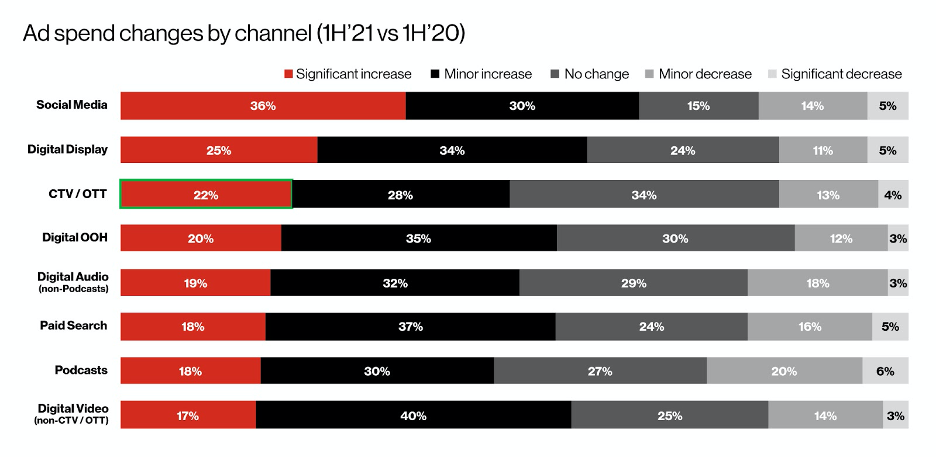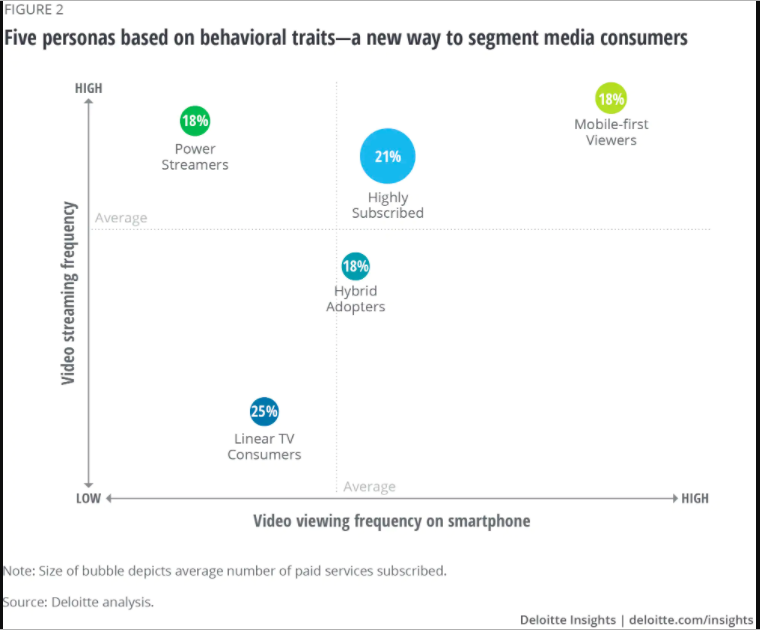Are you planning to invest in over-the-top (OTT) advertising this year? If so, your timing couldn’t be better. The world of advertising is experiencing a major change as companies move away from traditional broadcasting platforms like television to new ones like online streaming services.
That shift is exactly why OTT advertising is becoming more interesting to marketers; millions of people currently use online streaming services, and many don’t mind sitting through a few ads to access their content for free.
In this article, we’ll take a look at six OTT major advertising trends that will guide many companies investing in this strategy. Before we do that, though, a quick note on terminology: OTT is related to another acronym term, CTV, which stands for “connected TV.”
OTT is used to describe the process of streaming content on a device that bypasses traditional TV (by going “over the top” of the traditional broadcast market), while CTV is used to refer to the device itself that enables OTT streaming. So, CTV is the object, while OTT is the general phenomenon. Now that we’ve clarified that distinction, let’s dive in!
1. The Market Continues to Expand
As the world continues to move online, OTT advertising is taking over the traditional TV experience. More and more companies are realizing the importance of investing in this advertising medium to connect with customers.
In fact, eMarketer’s fresh data shows that the connected TV (CTV) advertising market has increased by 25% in 2020 alone. About 57% of digital advertisers are planning to increase spending this year, meaning that more businesses consider OTT to be a viable channel for achieving marketing goals.

More investment is likely to be made by the end of 2021, so the market will get a little bit more crowded in the coming months. Still, the share of marketers investing in other channels like social media and paid advertising is much higher, so the OTT video space should remain a major opportunity for businesses.
2. Getting OTT Video Essentials Right Is Crucial
As more brands begin making OTT ads, they’ll need to follow a set of essential requirements to comply with the new distribution channel. Some of the most important elements are format and length.
First, let’s talk about the format.
Brands will have to ensure that OTT video ads can be viewed comfortably across the whole range of streaming devices. When OTT advertising providers place the video segments, the ads can appear on small smartphone screens, medium-sized laptop screens, and large smart TV screens, depending on the viewer’s chosen streaming device.
To ensure comfortable viewing, brands will need to ensure that their content scales appropriately across each of those options.
Second, let’s talk about the length.
There are two types of OTT ads to be aware of: skippable ads. and non-skippable ads.
So, while making a long ad feel like a better idea to share more detail, brands will have to remember that viewers can skip many OTT ads. Getting the key message across within a short time frame is critical to ensure that you reach viewers who do skip the ad as soon as they can.
As for non-skippable ads, the ad length can vary between 15 and 30 seconds. Although this option makes it possible to reach a captive audience that can’t bypass the ad, keeping the scope short and focused is a must.
Getting these OTT essentials right during ad video production will be essential to ensure comfortable ad viewing, which leads to more brand and product exposure.
3. Hyperlocalization of Ads
Geographical location is a major customer segmentation factor that ensures the relevance of ads to viewers. With OTT advertising, brands have an opportunity to reach people living in designated market areas such as states, cities, and even zip codes.
In fact, marketers call this feature “local OTT advertising,” and it has been experiencing massive growth. The market grew by 127% in 2019 alone, while the number of advertisers increased by 33%. One of the major reasons for such growth is that businesses can reach their local audiences at an affordable cost with hyper-specific targeting.
Indeed, the implications of local OTT advertising for businesses can be significant, especially for brick-and-mortar stores.
“A local restaurant can run an ad of a special lunch offer around lunch hours to raise awareness and encourage buying,” says Joanna Wiatrowski, a business analyst from GetGoodGrade. “In this case, sharing details like a business’s location, special offers, and time frames are important to let customers know how they can buy.”
In this way, advanced localization options allow OTT advertising to “shrink” the geographical location of ad reach. This means that the audience viewing the ad will be more likely to express interest in visiting a business.
4. Interactive Ads
Devices like smartphones and tablets present another interesting opportunity for companies investing in OTT advertising: interactivity. Touchable screens allow viewers to interact with ads instead of passively watching them.
Interactive OTT video ad features include clickable hotspots, call-to-action (CTA) buttons, dynamic content, and gamification. For example:
- Gamification. A game development business can advertise its products by giving customers “a little taste of the game.” This means allowing them a few clicks to pass a simple level and see what the game is all about.
- Poll. An OTT ad can have a poll for customers, which can help businesses collect valuable feedback about their audiences.
- Social media sharing. Ad viewers can share a brand’s message on social media.
- Website visit. A CTA button can lead ad viewers directly to a brand’s homepage or a landing page.
The element of interactivity can increase viewer engagement and click rates. Even a simple “See More” button can make a difference for advertising campaigns by giving viewers a chance to learn about the brand, product, or offer.
5. Live OTT Ads
Live TV is becoming a thing of the past. Now, instead, we tune into live broadcasts on social media and streaming services. In 2020, Fast Company reported that 1.3 million US households canceled traditional cable or satellite TV subscriptions while some live streaming services grew customer bases by 300% and more.
Live broadcasts are a major opportunity for advertisers. On social media, for example, live videos get twice as much engagement as pre-recorded videos. Plus, it’s possible to stream just about any event or sports game—and take advantage of the numerous opportunities to showcase video ads.
Given the rising popularity of streaming services, more advertisers will be looking for ways to bring their content to these untapped markets. So, we should see more companies investing in streaming platforms providing live ad opportunities.
Benefits of airing live OTT ads:
- Customer research. Streaming platforms can provide a gold mine of data regarding who watched the event and/or ad.
- Access to a huge customer base. Advertise to hundreds of thousands of viewers depending on the event.
- Regular ad exposure. Hundreds of events like sports games happen every year, offering advertisers a never-ending supply of events to choose from.
If you’re used to advertising on traditional channels, those networks are available on streaming services, too. For example, you can tune into ESPN on at least 7 streaming platforms, including YouTube TV, Hulu Live TV, and AT&T TV.
6. New Behavior-Based Customer Personas
Customer personas are representations of typical customers based on research. Companies use them to create more relevant marketing messages for their target audiences. Those investing in OTT advertising will have to consider some more customer behaviors to create relevant ads.
This Deloitte survey revealed five customer personas to describe people who use digital streaming technologies based on video streaming frequency and video viewing frequency on smartphones.
These five personas are:
- Mobile-First Viewers. These users love to watch videos on social media and streaming services and are more likely to make purchases from ads, even from mobile. (Mean age: 33 years)
- Power Streamers. These users are prolific viewers of video streaming services who are hard to reach—about 40% have ad blockers installed. (Mean age: 41 years)
- Highly Subscribed. About 80% of this group are subscribed to both pay-TV and video streaming services. (Mean age: 42 years)
- Hybrid Adopters. This segment prefers to switch between traditional TV services and streaming services. (Mean age: 43 years)
- Linear TV Consumers. These consumers prefer traditional TV services over streaming options. (Mean age: 57 years)
This figure shows the U.S. market shares of these customer personas. The Linear TV Consumers, also known as “traditionalists,” still own the largest share of 25%, but the Highly Subscribed — those favoring video streaming services — are closing in with 21%.

Companies entering the OTT advertising space will have to adjust their marketing strategies to account for these customer personas.
Here are examples of how each persona influences video marketing strategies:
- Mobile-first viewers are the most open to sharing personal data to receive more customized ads, as long as the provider is transparent about its use.
- Power streamers prefer to watch on-demand video content on flat TVs, so advertisers will have to ensure a TV-friendly ad format for comfortable viewing.
- Highly subscribed viewers love to watch live broadcasts and sports games, so advertisers can influence them with personalized video ads.
- Hybrid adopters often agree to share personal details for a more personalized ad experience, so OTT ads could work well to engage them.
- Linear TV consumers are highly suspicious of targeted ads, so brands may prefer to engage this audience with traditional video ads.
This knowledge will guide online advertising strategies in 2021, as knowing how each group reacts to online ads will help make better decisions.
OTT Ad Trends in 2021: Summary
There you have it: the six biggest trends in OTT advertising that businesses will have to account for in 2021. As you can see, ad personalization and customer research remain key to success, so best-performers will be those who excel at developing relevant content.
Video quality is also something that will define the success of OTT ad campaigns. Mastering the best practices ensures a positive viewing experience and higher customer engagement.
While these trends may or may not stick around long-term, one thing is for sure — OTT video advertising will become more popular in the next few years. Companies that invest in creating high-quality videos should improve marketing performance, because ads now belong online.
By Dorian Martin at NotBusinessAsUsual


